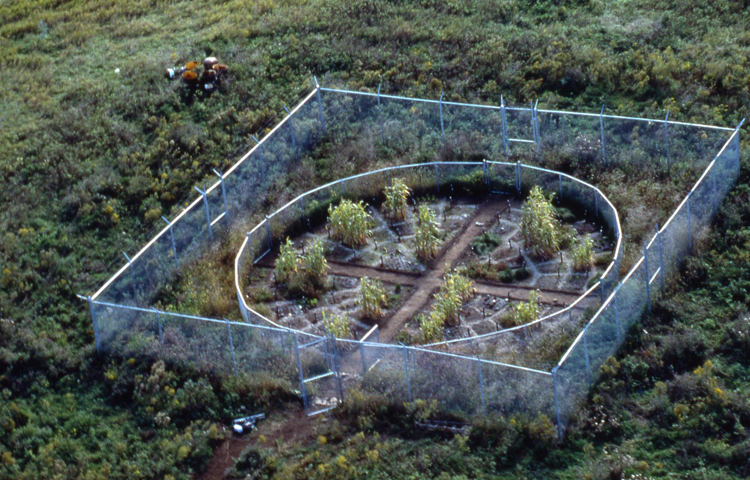
Revival Field began as a conceptual artwork with the intent to sculpt a site’s ecology. 1993 marked a successful conclusion to the first phase of this collaborative effort. The initial experiment, located at Pig’s Eye Landfill, a State Superfund site in St. Paul, Minnesota, was a replicated field test using special hyperaccumulator plants to extract heavy metals from contaminated soil. Scientific analysis of biomass samples from this field confirmed the potential of “Green Remediation” as an on-site, low-tech alternative to current costly and unsatisfactory remediation methods. Despite soil conditions adverse to metal uptake, a variety of Thlaspi, the test plant with the highest capacity for hyperaccumulation, was found to have significant concentration of cadmium in its leaves and stems.
From article “Reclamation Art: Restoring and Commemorating Blighted Landscapes”
by Hillary Anne Frost-Kumpf
[Read Full Article]
“Artist Mel Cin has created a series of reclamation art projects called Revival Fields. The projects are intended as demonstrations of how certain plants can be used to safely remove and recycle heavy metals from the soil. Chin works closely with agronomist Rufus L. Chaney of the United States Department of Agriculture to test the effects of hyperaccumulator plant species on land contaminated with heavy metals such as cadmium and zinc. Various hybrids of corn, bladder campion, and alpine pennythrift, are being used to determine if the plants can detoxify the site. The idea is that the biomass would be regularly harvested and processed to reclaim and recycle the metals.
Revival Field I was at Pig’s Eye Landfill in St. Paul, Minnnesota, a “Superfund” site laced with cadmium. The field was planted for three growing seasons from 1990 to 1993. The artwork was a very formally laid out circle within a square, bisected by two crossed paths, signifying the earth as a target for regeneration. Revival Field II is a quarter circle planting in Palmerton, Pennsylvania (Figure 9). The entire community of Palmerton has been badly damaged by zinc fallout from nearly 80 years of zinc smelting in the area. The soils of the area have been made highly toxic and the mountains near the zinc plants have been totally stripped of vegetation. Revival Field II was planted in 1992 and will continue through the 1996 growing season. Chin also created two circular Revival Fields in The Netherlands. One is a control site at Zoetermeer, a planned community near The Hague, the other is on a contaminated smelting site near the Belgian border.
The scientific aspects of the Revival Fields appear to have been successful in terms of gathering data and raising awareness of the potential of hyperaccumulator plants. However, the art aspects of Revival Fields have been highly contested. An original grant from the National Endowment for the Arts for Revival Field I was awarded, rescinded, and then reinstated based on concerns that the project was not art. Similarly, the City Council of Palmerton expected that Chin’s Revival Field II would create a pretty garden, not a complex science project. But for Chin, the projects are sculpture in unseen material (biochemistry and agriculture) whose aesthetic is revealed in a revitalized earth. In addition, Chin included more subtle symbology in the design of the fences and plot markers at each site. By including elements of Mayan mathematical notation, Chin is apparently appealing to the antiquity of the necessary relations of humans to the earth.
Directions to Revival Field II: Northeast corner of Hazard and Delaware Streets in Palmerton, PA. First traffic light east of Route 248.”

